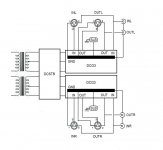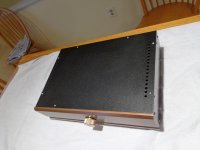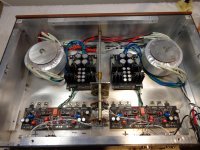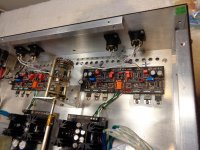I also use no SLB in my DCG3. The only one SLB of the whole system is located in the power amplifier. My DCG3 chassis has a bolted wire connected to mains earth. The signal ground is again bolted to chassis with a thick wire taken from one point only where the In-Select returns line and the channels input coax screens meet at the volume pot's return points bridged. Pot's metal parts are already at chassis potential because mechanically secured with an L bracket. DAC, preamp, power amp, are all using three wire IEC. No ground loops buzz in the background with ear on the HF horn's mouth.
Salas I thought that the purpose of a SLB/connection is only as a safety device that would permit current to be transmitted from the PCB or PSU to chassis if there was a catastrophic failure. This would be in addition to the mains earth to chassis connection. Maybe it is only needed in large current consumers like power amps?
nash
It's a safety device when you need the signal ground lifted from mains earth if a direct connection causes buzz in a system. In case of failure the SLB turns almost direct.
It's a safety device when you need the signal ground lifted from mains earth if a direct connection causes buzz in a system. In case of failure the SLB turns almost direct.
OK but if a resistor or CL60 is inserted in parallel with a diode bridge connection as is typical we still have a direct connection so the signal is not lifted. Maybe I misunderstand. I measured around 0.15VDC and around 9.0VAC between the DCSTB G point and chassis.
nash
I have finally started my build. A quick question regarding R3 on the DCG3 board. The schematic shows a 150R resistor. Teabag supplied 221R in the kit. Has there been a change, 221R ok to use or simply a mistake packaging all of the small parts.
Thanks
David
Thanks
David
Its on purpose. He found 221R better matching his J3(Q5) batch for circa 5mA in circuit current where my batch was lower average IDSS.
Got it, thanks Salas. Just wanted to be sure.
You could take a look to Teabag's blog, it contains useful information about the kit
http://www.diyaudio.com/forums/blogs/tea-bag/1340-salas-dcg-3-preamplifier-dcstb-power-supply.html
your sch says otherwise.Perhaps the scheme is not as clear as I would like. Circuit GND is not connected to chassis nowhere except at one point through the SLB. The rest wiring from pcb to inputs/outputs is as your suggestions
Pin1 is shown connected to a symbol. The other pin 1 is also connected to the same symbol.
The signal returns on the two RCA/Phono are shown connected to the same symbol.
That tells me you have taken the signal returns to the same chassis as the two pin 1 are connected to.
disconnect the two Pin1 from the audio.
Pin1 goes to chassis at the incomer.
The screen does not carry any signal, but it does carry interference.
You should not be connecting that interference to the audio side.
Pin1 goes to chassis at the incomer.
The screen does not carry any signal, but it does carry interference.
You should not be connecting that interference to the audio side.
pins 2 & 3 pass the signal.
The amp reads their difference and process that to become the output.
Do you remember that a signal needs two wires and those two wires should be close coupled along their whole route from source to receiver?
The amp reads their difference and process that to become the output.
Do you remember that a signal needs two wires and those two wires should be close coupled along their whole route from source to receiver?
it must, it cannot work any other way.It cannot amplify the difference at it's inputs!
The signal arrives over two wires, the amplifier reads that voltage difference and processes it.
That is why it is important to keep the two wire connection close coupled all the way from the source to the receiver.
Connect both XLR pin1's to the chassis is what Andrew is suggesting. You have RCA signal reference connected to the DCG3 so that should work fine too.
nash
nash
Actually, this is what I do at the moment and works fine, but I'll test it like post #1511 as I believe signal pass through chassis/SLB. I can only tell when I check this! Eventually, I may do the R7 mod.
Balanced build
Please see pics of my completed balanced build.
R7's are lifted and linked together.
I have been experimenting with XLR pin 1's and in this build for balanced use only the lowest noise is with pin1's to chassis which is where I have them now.
My attempts at installing a SLB have not been successful. I have tried at the DCSTB G and at the DCG3 G points but they both introduce a buzz. With no SLB and XLRpin 1's to chassis the amp is very quiet.
I will be replacing the 11/2 in heatsinks with 21/2 ones very soon. At 130ma they are getting around 52C with lid open and 64C with the lid on at ambient 22C.
Just a note that with R7's linked adjusting the DC offset of one phase effects the other.
My initial impression of the sound is that the stage is a bit wider and the sound more revealing than my BA3B/SalasBIb. Depth about the same although I feel the sound has moved a bit forward but the separation is outstanding. All the positions of the performers seem correct. A bit of harshness in the violins but I bet after 100 hrs that will be gone.
Thank you Salas for sharing your designs with us and for your very generous support. Thanks Tea-Bag for another excellent PCB production and for all the effort taken in providing matched parts.
nash
__________________
F5TV3, AVC, BA3 bal pre
Please see pics of my completed balanced build.
R7's are lifted and linked together.
I have been experimenting with XLR pin 1's and in this build for balanced use only the lowest noise is with pin1's to chassis which is where I have them now.
My attempts at installing a SLB have not been successful. I have tried at the DCSTB G and at the DCG3 G points but they both introduce a buzz. With no SLB and XLRpin 1's to chassis the amp is very quiet.
I will be replacing the 11/2 in heatsinks with 21/2 ones very soon. At 130ma they are getting around 52C with lid open and 64C with the lid on at ambient 22C.
Just a note that with R7's linked adjusting the DC offset of one phase effects the other.
My initial impression of the sound is that the stage is a bit wider and the sound more revealing than my BA3B/SalasBIb. Depth about the same although I feel the sound has moved a bit forward but the separation is outstanding. All the positions of the performers seem correct. A bit of harshness in the violins but I bet after 100 hrs that will be gone.
Thank you Salas for sharing your designs with us and for your very generous support. Thanks Tea-Bag for another excellent PCB production and for all the effort taken in providing matched parts.
nash
__________________
F5TV3, AVC, BA3 bal pre
Attachments
- Home
- Source & Line
- Analog Line Level
- Salas DCG3 preamp (line & headphone)




